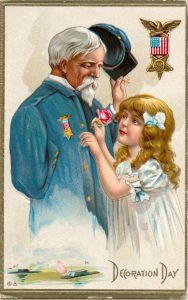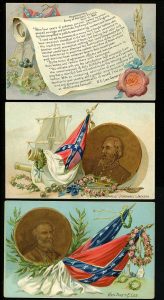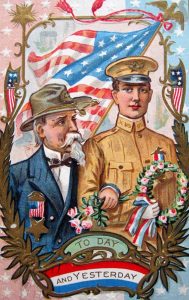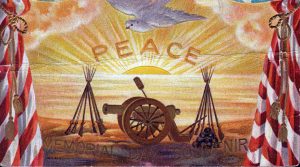“Strew the fair garlands where slumber the dead”
 I have always loved ephemera—those bits and pieces of printed paper, originally meant to have only short-term popularity. I particularly like old postcards from the end of the 19thcentury up through the 1920s. Commercial artists like Ellen Clapsaddle and lithographers Raphael Tuck and Sons created small works of art for the celebration of every possible holiday, especially Decoration Day/Memorial Day. New York City and British companies printed these cards which display a predictable Yankee sensibility.
I have always loved ephemera—those bits and pieces of printed paper, originally meant to have only short-term popularity. I particularly like old postcards from the end of the 19thcentury up through the 1920s. Commercial artists like Ellen Clapsaddle and lithographers Raphael Tuck and Sons created small works of art for the celebration of every possible holiday, especially Decoration Day/Memorial Day. New York City and British companies printed these cards which display a predictable Yankee sensibility.
Old postcards are not just useless dust collectors,  however. Memorial Day ephemera can give a brief-but-nuanced look at the political thoughts of the day. Many cards feature images celebrating the Union’s Grand Army of the Republic or the GAR. Earlier cards refer to the holiday as “Decoration Day,” but the iconography remains similar: the GAR 5-pointed star, eagles, flags, and guns with bayonets to honor Union veterans. Union vets themselves are shown as older men, often with missing limbs. Graves are honored with garlands of flowers by younger members of the next generations who stand close in honored awe.
however. Memorial Day ephemera can give a brief-but-nuanced look at the political thoughts of the day. Many cards feature images celebrating the Union’s Grand Army of the Republic or the GAR. Earlier cards refer to the holiday as “Decoration Day,” but the iconography remains similar: the GAR 5-pointed star, eagles, flags, and guns with bayonets to honor Union veterans. Union vets themselves are shown as older men, often with missing limbs. Graves are honored with garlands of flowers by younger members of the next generations who stand close in honored awe.
 A few years later, as Decoration Day edges toward Memorial Day (formally adopted in 1882), political thinking has changed. It now included reconciliation images. Union veterans welcome Confederate veterans to the graveyards, with hands extended in both directions. Iconography still does not include Confederate flags, and never will. Soldiers—old foes—are reconciled as citizens under one flag—the Stars and Stripes. I have only seen three postcards that venerate a Confederate general: Lee, Jackson, and Johnson. Stonewall Jackson’s card is replete with a sword, round shot, and the Stainless Banner, but behind him is a ship. Tuck and Sons did a limited edition of these cards for Confederate Memorial Day, but these are very difficult to find and quite expensive.
A few years later, as Decoration Day edges toward Memorial Day (formally adopted in 1882), political thinking has changed. It now included reconciliation images. Union veterans welcome Confederate veterans to the graveyards, with hands extended in both directions. Iconography still does not include Confederate flags, and never will. Soldiers—old foes—are reconciled as citizens under one flag—the Stars and Stripes. I have only seen three postcards that venerate a Confederate general: Lee, Jackson, and Johnson. Stonewall Jackson’s card is replete with a sword, round shot, and the Stainless Banner, but behind him is a ship. Tuck and Sons did a limited edition of these cards for Confederate Memorial Day, but these are very difficult to find and quite expensive.
As time continued toward World War One, the iconography again changed. Elderly Union vets stand arm-in-arm with young soldiers going off to fight The Great War. Images changed again for World War Two, with much less romanticism and more cartoons making fun of soldier life or celebrating war machinery in photographs. Perhaps folks were less sentimental, or more focused on the future than the past. The beautiful images of a forgotten, romanticized wartime disappeared along with the soldiers themselves and the now-antiquated technology which produced the Clapsaddle or Tuck cards.
iconography again changed. Elderly Union vets stand arm-in-arm with young soldiers going off to fight The Great War. Images changed again for World War Two, with much less romanticism and more cartoons making fun of soldier life or celebrating war machinery in photographs. Perhaps folks were less sentimental, or more focused on the future than the past. The beautiful images of a forgotten, romanticized wartime disappeared along with the soldiers themselves and the now-antiquated technology which produced the Clapsaddle or Tuck cards.
People rarely send postcards these days. Historical sites and military installations still sell them, but they usually feature modern photography and depict current images. These cards, which may seem lifeless to us, could one day be seen as indicative of their own time and place—a time and place of modern sensibilities and unromantic technology. Still, I like the old cards.
Filii Veteranorum. Gratia Dei Servatus.

Nice. Thanks.